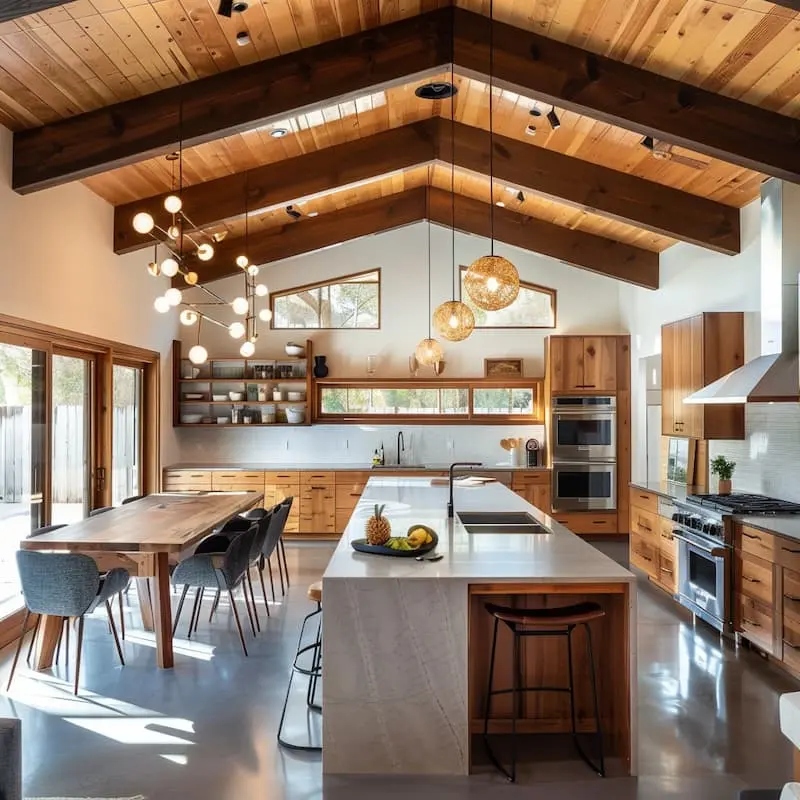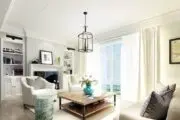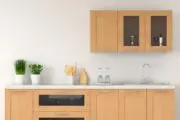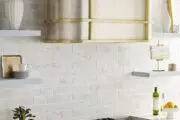Planning interior design and décor is rapidly evolving with emerging tech tools, such as generative artificial intelligence (AI), immersive metaverse spaces, and augmented reality (AR) helping consumers to engage more actively in their design decisions.
Gen AI, in particular, is useful and inspirational for design-curious consumers. Inputting simple, textual prompts in generative AI such as Midjourney delivers vivid and evocative images within seconds.
Midjourney is very easy to use, but it’s essential to craft prompts using language that aligns specifically with your interior design goals to get the images that you want, so users must proactively anticipate how the bot will respond to commands. Here is a guide to successfully creating Midjourney interior design prompts.
How Midjourney works
Users access Midjourney through a Discord account and enter prompts that begin with /imagine.
The Midjourney bot works through algorithms to create striking, colorful images. Midjourney is one of several text-to-image AI available, including Dall-E, but the quality and detail of the images that Midjourney generates make it particularly well-suited for interior design.
A word of caution for homeowners dabbling with Midjourney: The images generated are indeed inspirational, but they lack real-world functionality. Ideas presented don’t come with specifications, nor can you purchase the creations you see.
Instead, plan to use your images as a springboard to demonstrate your ideas to your partner, builder, contractor or designer, or use the images to source similar-looking colors, products and finishes in the marketplace.
It’s a fast pass for ideation and stokes creativity, as opposed to a blueprint.
“Remember that AI-generated images are a conceptual starting point for future projects and are not perfect,” says interior designer Gloribell Lebron of Lebron Interiors.
Determine what designs appeal to you before you begin
To guide the bot with Midjourney interior design prompts most effectively, you need to define what your aesthetic goals are.
“Before diving into the world of generative AI tools like Midjourney, it’s important to have a clear idea of what you want to achieve,” says Lebron.
Even though you are using cutting-edge tech with generative AI, it’s a good idea to use an old-school approach to source and organize your inspiration.
“Start by gathering inspiration from various sources such as design magazines, Pinterest, etc. Identify the elements that resonate with your style, such as color palettes, textures, and furniture types,” she says.
Assemble all these ideas on a mood board, which is essentially a collection of design inspiration pieces, and can include physical samples and pictures, or be done digitally.
“A mood board can help you to polish your vision and serve as a reference point,” says Lebron.
Brush up on interior design language
One of the benefits of Midjourney is that it is a way for users to articulate interior design ideas visually, useful in communicating concepts to designers or builders, or even amongst homeowners creating their wish list collaboratively.
Casual design enthusiasts, however, may know what they like, but they may not be familiar with the terminology to express their style.
As part of your exploration of ideas for your mood board, learn about different styles and design elements, keeping in mind that styles are carefully curated to produce a specific aesthetic.
For example, some of the most popular styles currently are:
- Japandi, which embraces warm woods and purposeful spaces.
- Farmhouse is rustic but style-centric, with lots of textured finishes and wood, such as timber frames and shiplap.
- Coastal design re-creates a beach vibe, with blues, greens, yellows and a conscious fusion of the indoor/outdoor connection.
- Popular in the mid-20th century, Mid-century modern is seeing a revival, with geometric design elements, featuring simple, clean lines.
There are dozens of named styles, so decide which best reflects your aesthetic, or choose a blend of a few, as is commonly done in interior design.
Similarly, consider the language that others use when writing about interior design.
Scroll through design media, and you will commonly see words such as moody, artistic, whimsical, tailored, textured and eclectic. Think about how adjectives are being used to describe some of your favorite looks and incorporate similar descriptions to your prompt plan.
Drill down the details
The more information you can provide Midjourney the better, so compile a checklist of design details to address.
“Creating effective language prompts for AI tools involves clarity and specificity,” says Lebron.
“Start with a detailed description of the overall style you desire—whether it’s modern, minimalist, or bohemian. Include specific details such as color palettes, types of materials, and furniture styles,” she says.
Some tips to keep in mind:
- The first part of the prompt is the most important, and details that follow will help to refine the image delivered.
- Remember room location and layout, approximate size or dimensions, architectural details, flooring, lighting and any other descriptions to refine your aesthetic direction.
- Assign adjectives to the room’s purpose. Are you designing a cozy bedroom, an airy, spacious family room, or a functional chef’s kitchen?
- Use simple, short prompts with strategically placed directives. Don’t use long, rambling lists and avoid short filler words such as “a” or “the”. Separate thoughts with commas instead.
- Be concrete, as Midjourney has a hard time recognizing abstract concepts.
“For instance, instead of saying ‘modern bathroom,’ you could say ‘modern bathroom with a neutral color palette, white marble floor tile, and dark blue one sink vanity’ (see example below). The more detailed your prompts, the more accurate the generated images will be,” says Lebron.
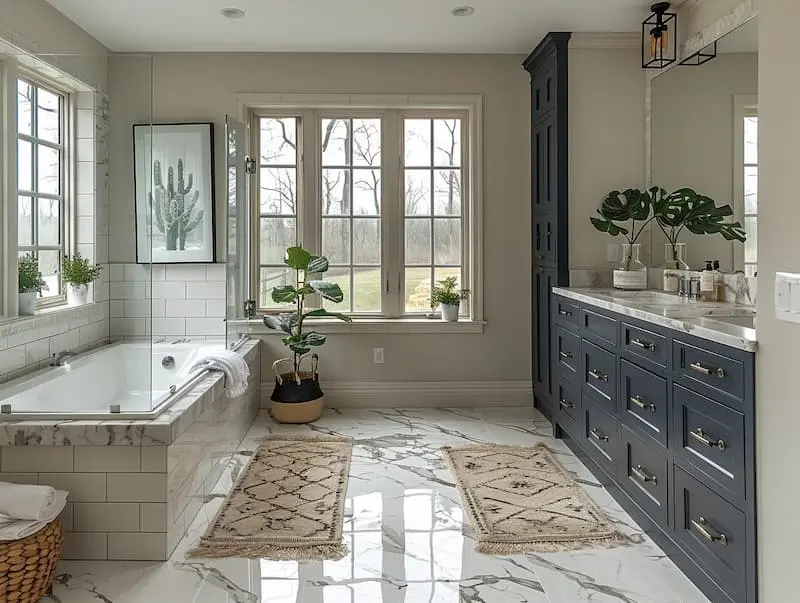
What if I am not getting the images I want?
“Start by refining your prompts—add more specific details or adjust the existing ones. Experiment with different keywords and combinations to see what yields better results,” says Lebron.
For example, in this image, I used the prompt:
/imagine large 20×20 open plan kitchen for entertaining in farmhouse and mid-century modern style
I liked it, but I had a different, more colorful image in my mind and I felt this room was a bit dark, so I thought about what language might brighten it up. I changed the prompt to:
/imagine large 20×20 open plan kitchen for entertaining in farmhouse and mid-century modern style neutral colored flooring bold colored cabinetry large island with built in seating chef-grade appliances light and airy feel natural light
In addition to more color in the second image, you can see greater interplay from the light, with more light fixtures, less shadows and more reflective surfaces, and emphasis on the view outside.
“If you’re not getting the images you want, don’t get discouraged,” says Lebron, as it may take a few tries to land the look you want.
In fact, the trial-and-error nature of Midjourney is often a welcome part of the creative process, given that you can easily tweak prompts to build different images.


